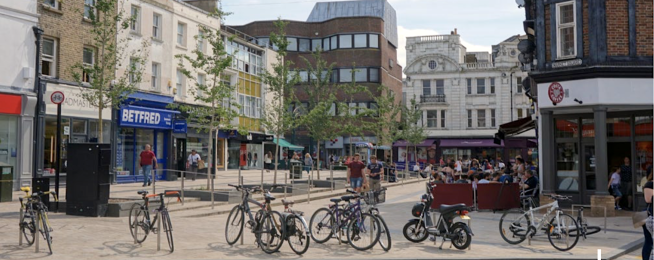Initiatives to improve main street environments by calming traffic and prioritising pedestrians and bikes provide economic benefits far beyond just more bike riders, studies are showing.
Shopping districts where car parking is reduced and placemaking improvements follow are showing remarkable economic transformation compared to those areas where the status quo prevails.
We must surely be reaching a tipping point where reflexive opposition to placemaking and safety upgrades on shopping streets is no longer tenable.
Traders have had a 40-year-old thought stuck in their heads: more cars and car parking is essential for business.
And they keep repeating it as customers disappear, trade evaporates, and for-lease signs grow in number — all as more and more cars jam the streets.
When will they wake up?
In London authorities have been comparing the performance of shopping precincts that have been given placemaking treatment with others that have not.
- Here are some findings:
An uplift in office rental values equivalent to an ‘additional’ 4% per annum. This helps to support investment in business space in the face of pressures to convert to more profitable residential uses. - A larger uplift in retail rental values equivalent to an ‘additional’ 7.5% per annum. This results from the more attractive retail environment that has been created and the encouragement this is giving to investment in these locations despite competition from on-line retail and ’out-of-town’ shopping centres.
- A strongly related decline in retail vacancy leading to a sizable 17% per annum difference in vacancy rates between improved and unimproved street environments.
- A large 96% boost in static (e.g. standing, waiting, and sitting) and 93% boost in active (e.g. walking) street behaviours in improved over unimproved areas, with strong potential health benefits in the resulting more active lifestyles.
- A particularly large 216% hike in the sorts of leisure based static activities (e.g. stopping at a café or sitting at a bench) that only happen when the quality of the environment is sufficiently conducive to make people wish to stay.
The researchers in a Transport for London report say that making more space for pedestrians and bicycles and less space (and slower speeds) for cars is fundamental to opening up the opportunity to deliver on the other factors that make for the highest quality street experience.
"Increasingly cities are choosing to see streets as more than just corridors that facilitate the movement of traffic,” the report says.
"Recognition of the vital ‘place’ function of streets reflects their role as environments within which we meet and socialise, where businesses are located, where we walk and cycle, and where the public life of the city thrives.
"As with all changes to streets, space is limited and better provision for one street function may have knock-on impacts on others. More space for cyclists, for example, may mean less space for cars or pedestrians, or that their ability to move is in some way constrained by the new infrastructure, for example by re-positioning parking."
The report says that attention to delivery logistics is vitally important to ensuring the success of street improvement projects.
Become our friend
Find out more about Bicycle Network and support us in making it easier for people to ride bikes.


